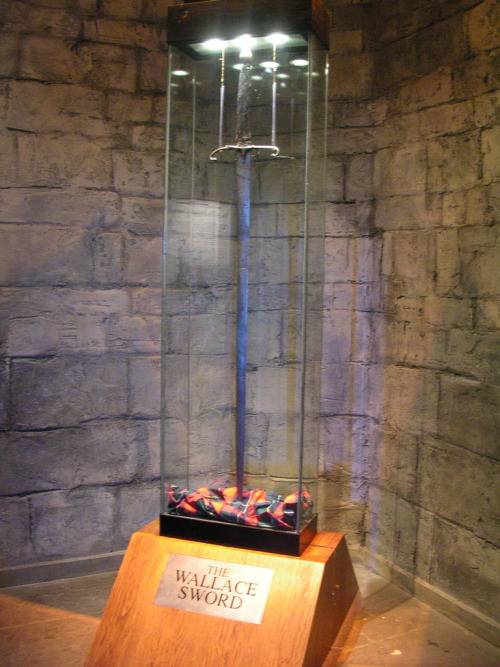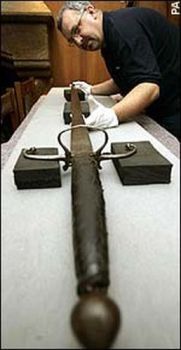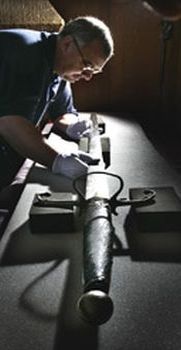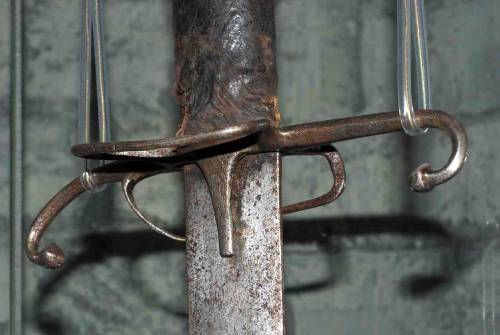art-of-swords:The Wallace SwordThe Wallace Sword is an antique claymore purported to have belonged t
art-of-swords:The Wallace SwordThe Wallace Sword is an antique claymore purported to have belonged to William Wallace (1285–1305), a Scottish knight who led a resistance to the English occupation of Scotland during the Wars of Scottish Independence. It is said to have been used by William Wallace at the Battle of Stirling Bridge in 1297 and the Battle of Falkirk (1298).The shaft of the sword measures 4 feet 4 inches (132 cm) in length and 5 feet 8 inches (173 cm) including the hilt. The breadth of the blade varies from 2.25 inches (5.7 cm) at the guard to 0.75 inches (1.9 cm) before the point. The sword weighs 6.0 pounds (2.7 kg).It has been alleged that after William Wallace’s execution in 1305, Sir John de Menteith, governor of Dumbarton Castle received the sword in August of that year. But there are no records to that effect.Two hundred years later, in 1505, accounts survive which state that at the command of King James IV of Scotland, the sum of 26 shillings was paid to an armourer for the “binding of Wallace’s sword with cords of silk” and providing it with “a new hilt and plomet” and also with a “new scabbard and a new belt”.This repair would have been necessary because, according to legend, Wallace’s original scabbard, hilt and belt were said to have been made from the dried skin of Hugh Cressingham, one of the English commanders at the Battle of Stirling Bridge.No other written records of the sword are found for a further three centuries. In 1875 a letter from the War Office informed that the sword, in 1825 was sent to the Tower of London to be repaired. At that time it was submitted to a Dr Samuel Meyrick by the Duke of Wellington for examination.Dr Meyrick was an authority on ancient swords, but he estimated the age of the sword by examining the mountings only, which as we know were replaced early in the 16th century. Thus he concluded that the sword could not date from earlier than the 15th century. However, he did not take account of the blade, which must have been of some importance for James IV to have it bound in silk and give it a new scabbard, hilt and belt, and it was also described then as the “Wallas sword”.The sword was recovered from Dumbarton by Charles Rogers, author of The Book of Wallace. Rogers, on 15 October 1888, renewed a correspondence with the Secretary of State for War, with the result that the Major General commanding forces in North Britain was authorised to deliver the weapon to his care for preservation in the Wallace Monument.There is good reason to believe that this sword as it is now did not belong to William Wallace. The blade does not possess a fuller — a near-universal feature of blades with this type of cross-section (lenticular) except in processional swords of the Renaissance. The blade in its original state would have likely been Oakeshott type XIIIa (also known as Espee de Guerrel or Grete war sword), which became common by the mid-13th century.Such swords would have a long, wide blade with parallel edges, ending in a rounded or spatulate tip. The grip, longer than in the earlier Scottish swords, typically some 15 cm (almost 6 inches), allows good two-handed use. The cross-guards were probably down-sloping (in the later highland style) or straight, and the pommel either regularly Brazil-nut or disk-shaped but this case perhaps a lobed pommel inspired by the Viking style.Close inspection reveals that it may be made up from pieces of different swords fitted together. Part of this could have come from a late-13th-century sword. David Caldwell, writes that “Apart from the reshaping of the guard, this sword does not appear untypical of the two-handed swords in use in the lowlands of Scotland in the late sixteenth or early seventeenth centuries.” (page 174) and that the blade has a ricasso, which is not a medieval feature.However, the blade appears to be made of 3 separate pieces hammer welded together. The bottommost piece has a flattened diamond cross-section, and so perhaps might be a 13th-century sword, and therefore there is some hope for those who think that Wallace’s sword is there.Source: Copyright 2014 © Wikipedia | Awesome Stories | The Guardian -- source link
#medieval#weapon porn#wallace#sword



